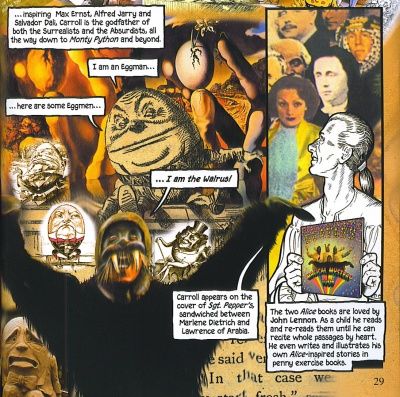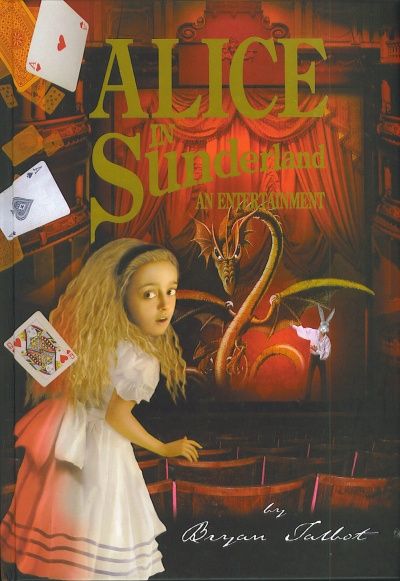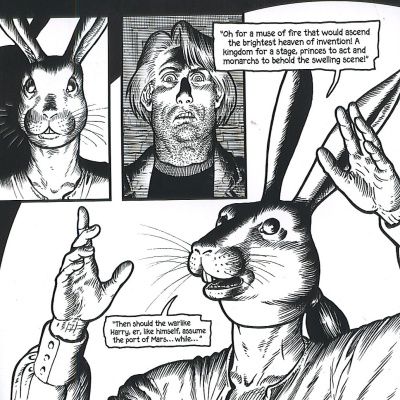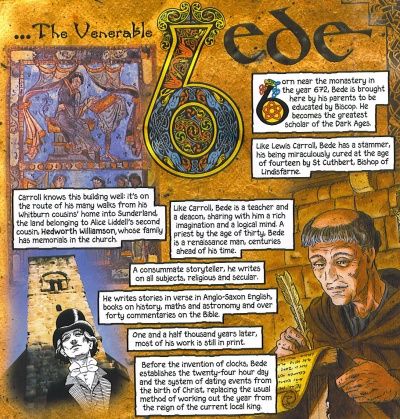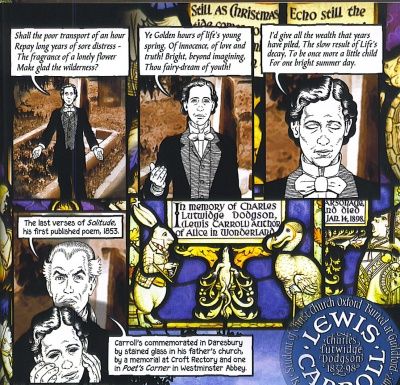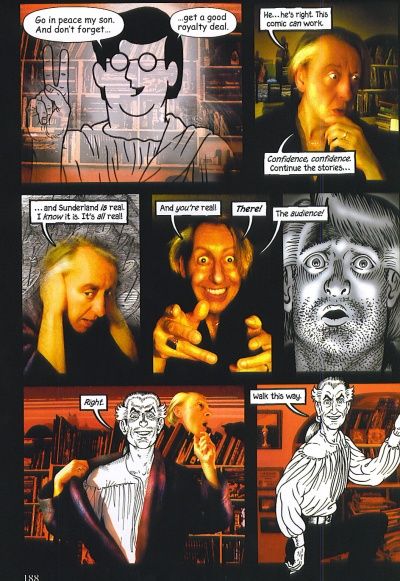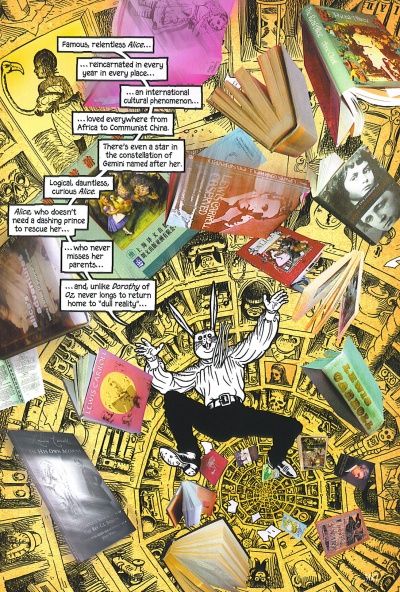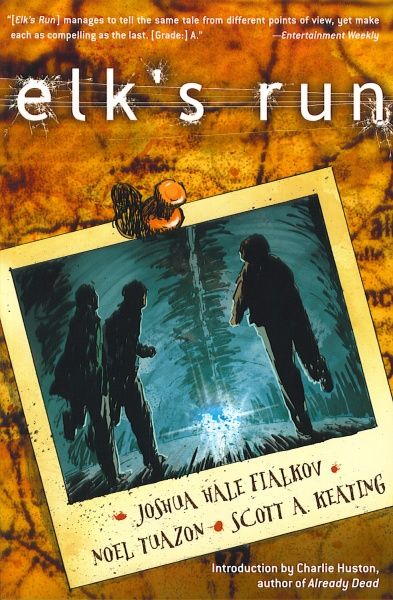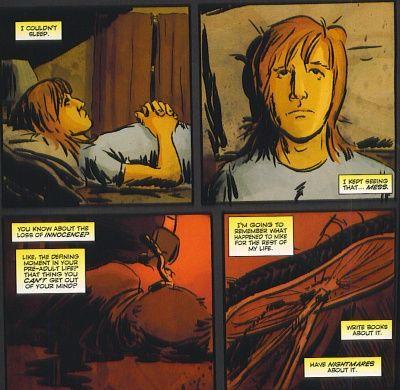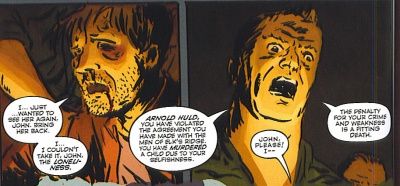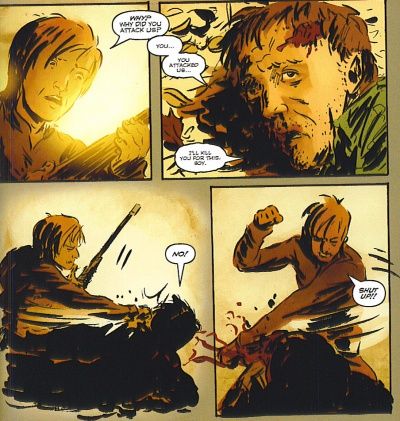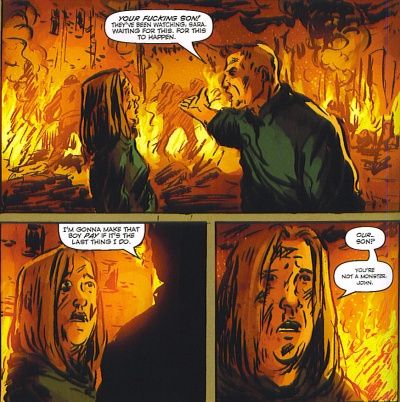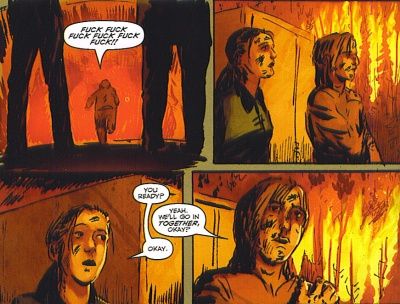Oh, you need a better reason? Well, okay.
Alice in Sunderland: An Entertainment is written and drawn by Bryan Talbot. It's published by Dark Horse, and costs 30 dollars. But it's a hefty book, packed with fabulous details, so it's totally worth it.
There are people in this world who won't be overly impressed by Alice in Sunderland. Those people, unfortunately, we will call Communists. Yes, dirty, stinking Commies who probably have posters of the East German women's swim team from the 1980s on their walls. Oh, for shame, people!
Okay, maybe that's a bit harsh. Alice in Sunderland is a pretty good example of a book that people might admire but not actually enjoy. I love it, but I can see why some people might not. Why? Because it's basically a lecture. A ridiculously interesting lecture about English history, especially the history of the North-East coastal area; Charles Dodgson and the creation of Alice in Wonderland and its effect on popular culture; and the way the past informs the present and how we relate to it and how we can honor the past while still looking toward the future. Talbot also considers how human beings interact with each other and the very nature of reality, but again, it's a lecture. Your mileage may vary with how long you can put up with a complete lack of narrative. Even if you don't enjoy the lecture, the book looks stunning.
Here's the set-up: A man walks into a theater, the Empire, where he's the only audience member. A man in a rabbit mask walks on stage, begins reciting the prologue from Henry V, but forgets the lines. Using this moment to muse about growing old, he mentions that the theater in which they're sitting is 100 years old that night, and this leads to the monumental lecture that goes on, with only a few interruptions, for the next 300 pages. The Empire is in the town of Sunderland, which is on the Wear River on England's North-East coast (here's a map). The actor, who is Talbot himself, begins with the history of the theater, but quickly moves beyond that to encompass English history and Lewis Carroll. Along the way he's joined by the Pilgrim (who's also Talbot; so is the audience member), who takes us on a walking tour through the city and into the countryside. Talbot links Charles Dodgson to the North, even though its contribution to the Alice stories has been largely ignored. Sunderland is not only important to Dodgson, but through its proximity to some of the great sites of English and Christian history, it's important to Western civilization as well. The Lindisfarne Gospels are produced near Sunderland. St. Bede (the Venerable) wrote his epic Ecclesiastical History of the English Nation in the North-East. The Synod of Whitby, which sealed the fate of Celtic Christianity in England and promoted the rise of Roman Catholicism, was held down the coast from Sunderland. As Talbot moves through history, he continues to link Sunderland to the greater British Empire, and by extension, to the West as a whole.
It's amazing how Talbot manages to link all these stories that permeate the North-East and England. He jumps back and forth between the past and the present, between Dodgson and the historical narrative, and his own experiences writing and drawing the book, as well as his interactions with the people of his street (he lives on St. Bede's Terrace, a reference to the writer) and the people of the city. It's a wonderful and daunting undertaking, but Talbot keeps it lively with humor and asides to the audience (either the one in the theater or the reader). He even experiences a moment of self-doubt as the creator, but a visit from Scott McCloud, dressed as an angel, alleviates that. It becomes not only a lecture, but a marvelous puzzle box of a story, drawing connections where none existed, looping back on itself, tying everything in the world together and linking it, and us, to Sunderland. This allows Talbot to make his final point, that we're all immigrants, bringing our own histories to our new lands, blending them to make the country, and that change brings renewal, and there's nothing wrong with it. It's a somewhat obvious point to make, but that doesn't change the fact that the journey to get there is magnificent.
As I wrote, the book is stunning to look at. Talbot blends drawing with old sketches of England, photo-reference, surveying maps, and other media such as book covers. For the older sketches, he simply reproduces the drawing, but for much of the other pictures, he does something very interesting, and I'm not sure how he does it. If you look closely, the photos he uses are not simply reproduced in the book. They are painted onto the page, as if Talbot used an intricatepaint-by-numbers set that showed the town of Sunderland, people in his neighborhood, even the Bayeux Tapestry. It's not just photographs of these things - they're definitely painted. I just don't know how - or, you know, why - Talbot did this. Did he take pictures of all these things and prop them next to his drawing board and then meticulously reproduce them? It seems so, but I suppose he could have used a more sophisticated technique that I don't know about. Whatever it is, it makes the book even more lovely, as it looks "real" in that the locations and people - Dodgson, Margaret Thatcher, the Duke of Wellington - are instantly recognizable, but it's clear they aren't photographs, but paintings. It's amazing to look at.
Alice in Sunderland is an astonishing and impressive comic book. It will make you rethink your place in the world, and make you marvel at the length and breadth of history. It sheds new light on a classic work of literature and helps us understand that work in the context of its time and its timelessness. It might not be the absolute best graphic novel you'll read this year, but it will certainly leave you the most breathless in its ambition, scope, and beauty.
Meanwhile, the other book you should buy right away is Elk's Run, which is written by Joshua Hale Fialkov and drawn by Noel Tuazon. It's published by Villard Books and costs $19.95. It's been a long time coming, but the wait is worth it.
The story is simplicity itself: in the town of Elk's Run, West Virginia, nobody ever leaves. The town was founded by Vietnam veterans who wanted to create a community that hearkened back to a more innocent time, so they built it and cut it off from the outside world. Their supplies are brought in periodically by a truck, but other than that, no one comes to visit. This is a bit of a problem for the teenaged boys, who are desperate to do what teenaged boys tend to do - rebel (well, and get laid, but that's part of the problem - there are only 4 girls in town, and none of them are the right age for the boys). One night, as four of them go into the tunnel leading to the outside world, one of them is killed by a car driven by a resident who's trying to escape. The townspeople exact some good old-fashioned vigilante justice, and John - the main character - sees it out his bedroom window. From that point on, he's just looking to escape. But of course it won't be that easy.
Fialkov does a wonderful job creating these characters and making even John's father (also named John) sympathetic, even though we see in a flashback to Vietnam that he's kind of evil. He abides by the law of the town because he believes that it's necessary to make a better world, and he clings to this belief even when his law might lead to the deaths of people he loves. John's mother, who is the focus of thedisturbing third chapter (when things really start to go wrong), is also a sympathetic character, despite her devotion to her husband's ideal. Fialkov doesn't give us any easy villain, and that makes the book even more gripping. These are simply people caught up in something that spirals quickly out of control, and any chance they have to escape unscathed is lost, tragically.
We can read this as a typical teen rebellion, and it is, on one level. It's more than that, though, because of the idea of the town and what the adults are trying to do. It becomes a metaphor for America, a country confronting the future and not liking what it sees and trying to turn back the clock. John and the adults are trying to protect their children from the evils of the world, and although that's a noble ideal, they can't recognize the foolishness of holding the reins too tightly. Kids rebel, and things change. The best thing parents can do is try to guide their children through. Imprisoning them, no matter how idyllic the prison is, never works. As the tension mounts and the problems within the community become insurmountable, we see that resisting change with such fervor never works. Elk's Run is a wonderfully thoughtful tale even as it becomes more and more harrowing. It is because we can understand the adults' point of view that even though the kids are obviously the heroes, we recognize that it's not easy for the adults to simply let go. That becomes the tragedy, as the inability to let go leads to needless deaths.
Tuazon's rough art is fantastic, as he draws a bucolic town in a forested and autumnal setting, not only evoking the innocence of a lost time but also the inevitable death of that time. There's an aura of loss in the art, as Scott Keating's colors combined with Tuazon's pencils give a beautiful patina to the town, as if it's just a fantasy, which, as it turns out, it is. Tuazon does a marvelous job with the apocalyptic later scenes, when the town is falling apart and war has erupted. It's a vision of hell, a vision that could have been avoided. It's fascinating to look at the flashback segments, as the Vietnam section looks vaguely like Darwyn Cooke, while the scenes of John Jr.'s younger days have a cartoony quality to them, creatinga true sense of the innocence of youth (even with the centerfold tha begins Chapter Six).
Elk's Run got a second chance when Villard picked it up and agreed to publish it, because apparently absolutely no one was reading the single issues. This is a marvelous comic that deserves all the accolades it gets (and deserves a better introduction than Charlie Huston's, which is ... odd, to say the least). There is no reason whatsoever for you not to buy this book. It's a gripping story with wonderful characters and excellent art. It's full of action but it also has some interesting things to say about our world and the way we run our lives. Do yourself a favor and buy it.
It's interesting that both of these books are about embracing change because it's nothing to fear, and how people who don't embrace change are ultimately swept into the dustbin of history. It's a very cool theme to explore, andTalbot and Fialkov do it in different yet fascinating ways. So you should just skip buying that latest issue of Mighty Avengers and save your money for these two books. They will not let you down. This I promise!

